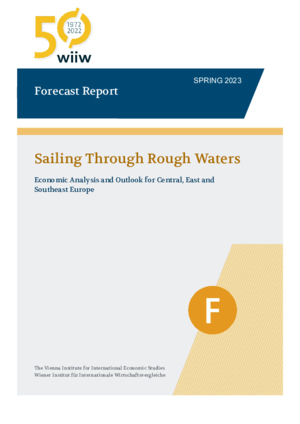Sailing Through Rough Waters
Vasily Astrov, Alexandra Bykova, Rumen Dobrinsky, Selena Duraković, Meryem Gökten, Richard Grieveson, Doris Hanzl-Weiss, Gabor Hunya, Branimir Jovanović, Niko Korpar, Sebastian Leitner, Ravik Mima, Beate Muck, Olga Pindyuk, Sandor Richter, Bernd Christoph Ströhm, Maryna Tverdostup, Nina Vujanović, Zuzana Zavarská and Adam Żurawski
wiiw Forecast Report No. Spring 2023, April 2023
148 pages including 28 Tables and 53 Figures
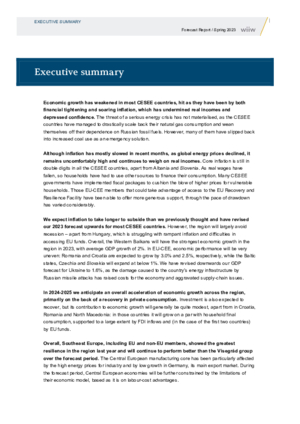
Executive summary
by Olga Pindyuk
free download
Indicators 2021-2022 and Outlook 2023-2025
Premium Members only
Summary of key recent macroeconomic data for CESEE, and overview of new wiiw forecasts for 2023-2025 (Excel file)
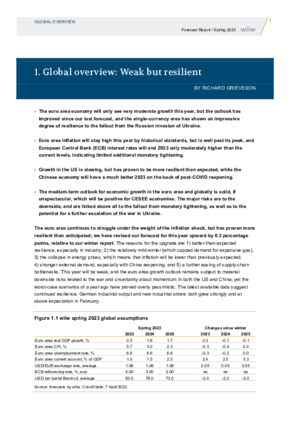
1. Global overview: Weak but resilient
by Richard Grieveson
The euro area economy will only see very moderate growth this year, but the outlook has improved since our last forecast, and the single-currency area has shown an impressive degree of resilience to the fallout from the Russian invasion of Ukraine. Euro area inflation will stay high this year by historical standards, but is well past its peak, and European Central Bank (ECB) interest rates will end 2023 only moderately higher than the current levels, indicating limited additional monetary tightening. Growth in the US is slowing, but has proven to be more resilient than expected, while the Chinese economy will have a much better 2023 on the back of post-COVID reopening. The medium-term outlook for economic growth in the euro area and globally is solid, if unspectacular, which will be positive for CESEE economies. The major risks are to the downside, and are linked above all to the fallout from monetary tightening, as well as to the potential for a further escalation of the war in Ukraine.
free download
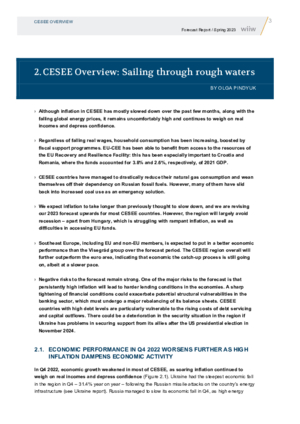
2. CESEE Overview: Sailing through rough waters
by Olga Pindyuk
Although economic activity has weakened considerably compared to last year, most of the economies of CESEE seem to have largely digested the economic shock caused by the Russian invasion of Ukraine and its fallout. All CESEE economies except Hungary and Russia will post positive full-year growth in 2023, and the region overall will outperform the euro area, indicating continued convergence. Most of the CESEE’s top performers this year will be in Southeast Europe. However, while inflation in CESEE has mostly slowed down over the past few months, along with the falling global energy prices, it remains uncomfortably high and continues to weigh on real incomes. We expect inflation to take longer than previously thought to slow down, and we are revising our 2023 forecast upwards for most CESEE countries. Negative risks to the forecast remain strong, including the impact of monetary tightening and uncertainty regarding the duration and outcome of the war in Ukraine.
free download
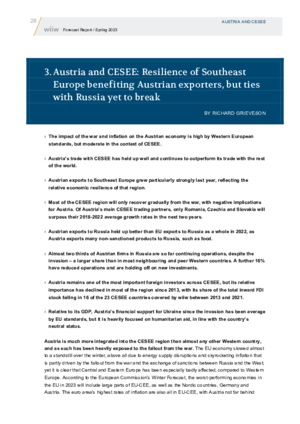
3. Austria and CESEE: Resilience of Southeast Europe benefiting Austrian exporters, but ties with Russia yet to break
by Richard Grieveson
The impact of the war and inflation on the Austrian economy is high by Western European standards, but moderate in the context of CESEE. Austria’s trade with CESEE has held up well and continues to outperform its trade with the rest of the world, and Austrian exports to Southeast Europe grew particularly strongly last year, reflecting the relative economic resilience of that region. Exports to Russia held up better than EU exports to Russia as a whole in 2022, as Austria exports many non-sanctioned products to Russia, such as food, while almost two thirds of Austrian firms in Russia are so far continuing operations, despite the invasion – a larger share than in most neighbouring and peer Western countries. Austria remains one of the most important foreign investors across CESEE, but its share of the total inward FDI stock fell in 16 of the 23 CESEE countries covered by wiiw between 2013 and 2021.
free download
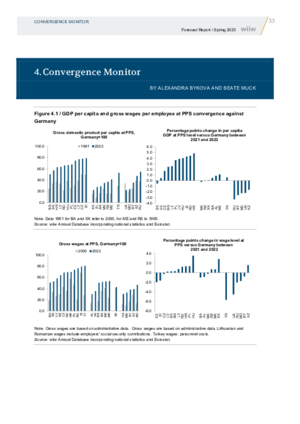
4. Convergence Monitor
by Alexandra Bykova and Beate Muck
free download
You can also download separate country reports of this report
| No. | Title | Author | |
|---|---|---|---|
| 1 | ALBANIA: Impressive resilience in the face of external shocks | Ravik Mima | Free Download |
| 2 | BELARUS: Grappling with a crippled economy | Rumen Dobrinsky | Free Download |
| 3 | BOSNIA AND HERZEGOVINA: Newly approved EU candidate status offers glimmer of hope | Selena Duraković | Free Download |
| 4 | BULGARIA: Political mess drives the economy towards an unsustainable fiscal course | Rumen Dobrinsky | Free Download |
| 5 | CROATIA: Uncertainty persists in the wake of the euro introduction | Bernd Christoph Ströhm | Free Download |
| 6 | CZECHIA: Inflation proving hard to tame | Zuzana Zavarská | Free Download |
| 7 | ESTONIA: A momentary dip, rather than recession | Maryna Tverdostup | Free Download |
| 8 | HUNGARY: In the grip of high inflation | Sandor Richter | Free Download |
| 9 | KAZAKHSTAN: Robust growth despite lower oil prices | Alexandra Bykova | Free Download |
| 10 | KOSOVO: Strong exports and public investment to sustain growth in 2023 | Ravik Mima | Free Download |
| 11 | LATVIA: Stagnation with high employment levels | Sebastian Leitner | Free Download |
| 12 | LITHUANIA: Cooling-down period expected to remain short | Sebastian Leitner | Free Download |
| 13 | MOLDOVA: Recovery depends on weather conditions and foreign assistance | Gabor Hunya | Free Download |
| 14 | MONTENEGRO: A new era ahead | Nina Vujanović | Free Download |
| 15 | NORTH MACEDONIA: Defying the winter blues | Branimir Jovanović | Free Download |
| 16 | POLAND: A temporary slowdown in growth | Adam Żurawski | Free Download |
| 17 | ROMANIA: EU-financed investments cushioning the slowdown | Gabor Hunya | Free Download |
| 18 | RUSSIA: Resilience to sanctions accompanied by structural change | Vasily Astrov | Free Download |
| 19 | SERBIA: Cloudy with a chance of sun | Branimir Jovanović | Free Download |
| 20 | SLOVAKIA: Political instability threatens future prospects | Doris Hanzl-Weiss | Free Download |
| 21 | SLOVENIA: The economy expected to stay steady while important reforms are pending | Niko Korpar | Free Download |
| 22 | TURKEY: Election uncertainty looming | Meryem Gökten | Free Download |
| 23 | UKRAINE: Economy defying the odds | Olga Pindyuk | Free Download |
Although economic activity has weakened considerably compared to last year, most of the economies of CESEE seem to have largely digested the economic shock caused by the Russian invasion of Ukraine and its fallout. All CESEE economies except Hungary and Russia will post positive full-year growth in 2023. From 2024 the recovery should continue to strengthen across the region, although monetary tightening and the uncertain duration and outcome of the war are downside risks to the outlook.
Reference to wiiw databases: wiiw Annual Database, wiiw Monthly Database, wiiw FDI Database
Keywords: CESEE, Central and Eastern Europe, economic forecast, Western Balkans, Visegrad group, CIS, Ukraine, Russia, Turkey, euro area, EU, convergence, Russia-Ukraine war, Russia sanctions, commodity prices, inflation, energy crisis, gas, coal, renewable energy, electricity, monetary policy, fiscal policy, EU funds, purchasing power, remittances, external debt, interest rates, banking sector, financial liabilities, credit, impact on Austria, macroeconomic forecasting
JEL classification: E20, E21, E22, E24, E31, E44, E5, E62, F21, F24, F30, F50, F51, H56, H60, J30, O47, O52, O57, P24, P27, P33, P52, Q40, R30
Countries covered: Albania, Austria, Belarus, Bosnia and Herzegovina, Bulgaria, Central and East Europe, CESEE, CIS, Croatia, Czechia, Estonia, Euro Area, European Union, Hungary, Kazakhstan, Kosovo, Latvia, Lithuania, Moldova, Montenegro, North Macedonia, Poland, Romania, Russia, Serbia, Slovakia, Slovenia, Southeast Europe, Turkey, Ukraine, US, Western Balkans
Research Areas: Macroeconomic Analysis and Policy, International Trade, Competitiveness and FDI
ISBN-13: 978-3-85209-077-1
Press Releases
- Turkey's economy at a crossroads (English)
- Turkey's economy at a crossroads (German)
- Spring Forecast: Eastern Europe growing more strongly than the euro area (English)
- Spring Forecast: Eastern Europe growing more strongly than the euro area (German)
Related Presentations
- Sailing Through Rough Waters (webinar presentation in English)
- Unterwegs aus rauer See (press webinar presentation in German)
Related News
- Spring Forecast: Eastern Europe growing more strongly than the euro area
- Turkey’s economy at a crossroads
